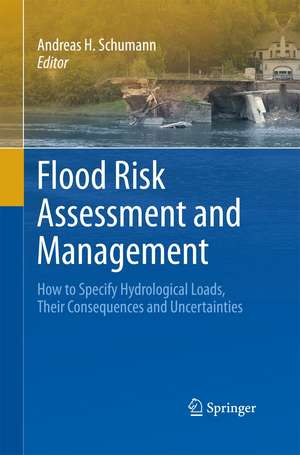Flood Risk Assessment and Management: How to Specify Hydrological Loads, Their Consequences and Uncertainties
Editat de Andreas H. Schumannen Limba Engleză Paperback – 15 oct 2014
| Toate formatele și edițiile | Preț | Express |
|---|---|---|
| Paperback (1) | 640.24 lei 6-8 săpt. | |
| SPRINGER NETHERLANDS – 15 oct 2014 | 640.24 lei 6-8 săpt. | |
| Hardback (1) | 644.82 lei 6-8 săpt. | |
| SPRINGER NETHERLANDS – 5 ian 2011 | 644.82 lei 6-8 săpt. |
Preț: 640.24 lei
Preț vechi: 753.22 lei
-15% Nou
Puncte Express: 960
Preț estimativ în valută:
122.50€ • 127.92$ • 101.16£
122.50€ • 127.92$ • 101.16£
Carte tipărită la comandă
Livrare economică 15-29 aprilie
Preluare comenzi: 021 569.72.76
Specificații
ISBN-13: 9789400789838
ISBN-10: 9400789831
Pagini: 292
Ilustrații: X, 279 p.
Dimensiuni: 155 x 235 x 15 mm
Greutate: 0.41 kg
Ediția:2011
Editura: SPRINGER NETHERLANDS
Colecția Springer
Locul publicării:Dordrecht, Netherlands
ISBN-10: 9400789831
Pagini: 292
Ilustrații: X, 279 p.
Dimensiuni: 155 x 235 x 15 mm
Greutate: 0.41 kg
Ediția:2011
Editura: SPRINGER NETHERLANDS
Colecția Springer
Locul publicării:Dordrecht, Netherlands
Public țintă
ResearchCuprins
Preface.- 1. Hydrological aspects of risk management.- Uncertainties in weather forecast - reasons and handling.- 3. Interpolation of precipitation for flood modelling.- 4. Framing uncertainties in flood forecasting with ensembles.- 5. Design of artificial neural networks for flood forecasting.- 6. Advances in regionalising flood probabilities.- 7. Rainfall generators for application in flood studies.- 8. Copulas - New Risk Assessment Methodology for Dam Safety.- 9. Hydraulic Modelling.- 10. Groundwater – the Subterranean Part of Flood Risk.- 11. Quantification of socio-economic flood risks.- 12. Application of scenarios and multi-criteria decision making tools in flood polder planning.- Index.
Notă biografică
Prof. Andreas Schumann studied hydrology and water management at the Technical University, Dresden. From 1981 to 1988 he held different positions in water management authorities: district hydrologist, head of a department and vice-director. From 1989 to 2001 he was a senior lecturer for Hydrology and Water Management at the Ruhr- University Bochum. Since 2001 he has the chair for Hydrology, Water Management and Environmental Techniques at the Ruhr- University Bochum, Germany. Prof. Schumann is Vice-President of ICWRS (Water Resource Systems) of International Association of Hydrological Sciences.
Textul de pe ultima copertă
This book examines many aspects of flood risk management in a comprehensive way. As risks depend on hazard and vulnerabilities, not only geophysical tools for flood forecasting and planning are presented, but also socio-economic problems of flood management are discussed.
Starting with precipitation and meteorological tools to its forecasting, hydrological models are described in their applications for operational flood forecasts, considering model uncertainties and their interactions with hydraulic and groundwater models. With regard to flood risk planning, regionalization aspects and the options to utilize historic floods are discussed. New hydrological tools for flood risk assessments for dams and reservoirs are presented. Problems and options to quantify socio-economic risks and how to consider them in multi-criteria assessments of flood risk planning are discussed. This book contributes to the contemporary efforts to reduce flood risk at the European scale. Using many real-world examples, it is useful for scientists and practitioners at different levels and with different interests.
Starting with precipitation and meteorological tools to its forecasting, hydrological models are described in their applications for operational flood forecasts, considering model uncertainties and their interactions with hydraulic and groundwater models. With regard to flood risk planning, regionalization aspects and the options to utilize historic floods are discussed. New hydrological tools for flood risk assessments for dams and reservoirs are presented. Problems and options to quantify socio-economic risks and how to consider them in multi-criteria assessments of flood risk planning are discussed. This book contributes to the contemporary efforts to reduce flood risk at the European scale. Using many real-world examples, it is useful for scientists and practitioners at different levels and with different interests.
Caracteristici
The book combines selected research results, framed by contemporary descriptions of meteorological base of flood forecasts, regionalization, etc. The contributors are the leading scientists in the field It is a comprehensive, interdisciplinary and practically orientated book of topical scientific interest








